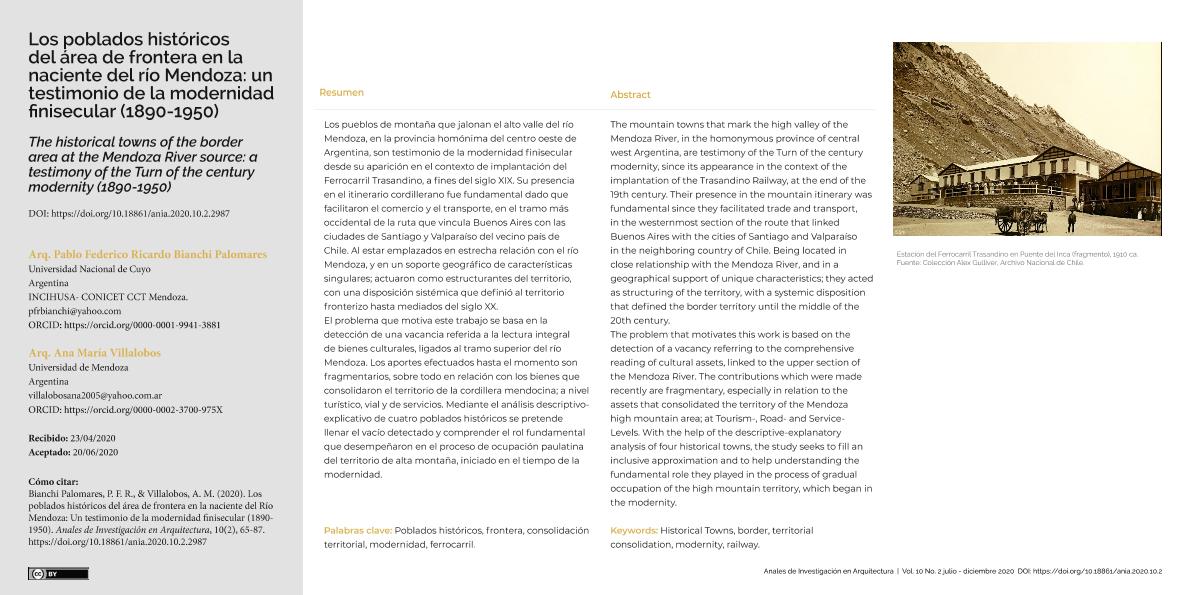Artículo
Los pueblos de montaña que jalonan el alto valle del río Mendoza, en la provincia homónima del centro oeste de Argentina, son testimonio de la modernidad finisecular desde su aparición en el contexto de implantación del Ferrocarril Trasandino, a fines del siglo XIX. Su presencia en el itinerario cordillerano fue fundamental dado que facilitaron el comercio y el transporte, en el tramo más occidental de la ruta que vincula Buenos Aires con las ciudades de Santiago y Valparaíso del vecino país de Chile. Al estar emplazados en estrecha relación con el río Mendoza, y en un soporte geográfico de características singulares; actuaron como estructurantes del territorio, con una disposición sistémica que definió al territorio fronterizo hasta mediados del siglo XX. El problema que motiva este trabajo se basa en la detección de una vacancia referida a la lectura integral de bienes culturales, ligados al tramo superior del río Mendoza. Los aportes efectuados hasta el momento son fragmentarios, sobre todo en relación con los bienes que consolidaron el territorio de la cordillera mendocina; a nivel turístico, vial y de servicios. Mediante el análisis descriptivo-explicativo de cuatro poblados históricos se pretende llenar el vacío detectado y comprender el rol fundamental que desempeñaron en el proceso de ocupación paulatina del territorio de alta montaña, iniciado en el tiempo de la modernidad. The mountain towns that mark the high valley of the Mendoza River, in the homonymous province of central west Argentina, are testimony of the Turn of the century modernity, since its appearance in the context of the implantation of the Trasandino Railway, at the end of the 19th century. Their presence in the mountain itinerary was fundamental since they facilitated trade and transport, in the westernmost section of the route that linked Buenos Aires with the cities of Santiago and Valparaíso in the neighboring country of Chile. Being located in close relationship with the Mendoza River, and in a geographical support of unique characteristics; they acted as structuring of the territory, with a systemic disposition that defined the border territory until the middle of the 20th century. The problem that motivates this work is based on the detection of a vacancy referring to the comprehensive reading of cultural assets, linked to the upper section of the Mendoza River. The contributions which were made recently are fragmentary, especially in relation to the assets that consolidated the territory of the Mendoza high mountain area; at Tourism-, Road- and ServiceLevels. With the help of the descriptive-explanatory analysis of four historical towns, the study seeks to fill an inclusive approximation and to help understanding the fundamental role they played in the process of gradual occupation of the high mountain territory, which began in the modernity
Los poblados históricos del área de frontera en la naciente del río Mendoza: Un testimonio de la modernidad finisecular (1890-1950)
Título:
The historical villages of Mendoza river border head area: A testimony of finisecular modernity (1890-1950)
Fecha de publicación:
08/2020
Editorial:
Universidad ORT Uruguay
Revista:
Anales de Investigación en Arquitectura
ISSN:
2301-1513
e-ISSN:
2301-1505
Idioma:
Español
Tipo de recurso:
Artículo publicado
Clasificación temática:
Resumen
Palabras clave:
POBLADOS HISTÓRICOS
,
FRONTERA
,
CONSOLIDACIÓN TERRITORIAL
,
FERROCARRIL
Archivos asociados
Licencia
Identificadores
Colecciones
Articulos(INCIHUSA)
Articulos de INST. DE CS. HUMANAS, SOC. Y AMBIENTALES
Articulos de INST. DE CS. HUMANAS, SOC. Y AMBIENTALES
Citación
Bianchi Palomares, Pablo Federico Ricardo; Villalobos, Ana María; Los poblados históricos del área de frontera en la naciente del río Mendoza: Un testimonio de la modernidad finisecular (1890-1950); Universidad ORT Uruguay; Anales de Investigación en Arquitectura; 10; 8-2020; 65-94
Compartir
Altmétricas




